Pros
Cons
Introduction
Design & Appearance
{{section_header}}{{section.name}}{{/section_header}}
The D7000 is a brick of a camera, weighing in at over 24 ounces without the lens. You are certainly going to feel that weight when it is around your neck, but that's not unusual with cameras like this. It certainly feels robust, though; the covers snap tightly closed and the buttons and dials feel like they would stand up to an extensive amount of use and rough treatment. Nikon claims that the body is built around a magnesium alloy frame along with a large number of rubber seals that keep out dust and water. We didn't test this (we doubt Nikon would have appreciated us dunking the pre-production samples that were on show at the Photokina show), but it does feel very solidly built and should stand up to rough treatment.
It also shares the same black plastic styling as other Nikon SLRs, which is a good thing: this camera is about function rather than form. But it manages to look sharp enough that it wouldn't disgrace you if you were shooting on the catwalks of Milan.
Tour
{{section_header}}{{section.name}}{{/section_header}}




LCD & Viewfinder
{{section_header}}{{section.name}}{{/section_header}}
The LCD of the D7000 is an impressive looking 3-inch model with a resolution of 921k pixels. That is enough to show sharp previews and captured images, although you will need to zoom in to see the fine detail. Unlike many other SLRs, this screen cannot be rotated or flipped around: it is fixed into the body of the camera.
8 levels of backlighting are offered, and we found the screen to be very sharp and bright. We were not able to test it in full daylight, but we have found that previous Nikon screens held up well in daylight. Old school users will also appreciate the prescence of a secondary LCD display on the top of the camera body, which shows shooting information such as shutter speed, aperture, white balance settings, etc.


Above the LCD screen is the optical viewfinder. Like all true SLRs, what you see in this is what the camera sees through the lens, with the light bounced up into the viewfinder by a lens inside the body. The camera overlays a lot of information onto this, including a strip at the bottom that shows the camera shooting information, such as shutter speed, aperture, etc. A number of small rectangles are also visible in the image, showing the 39 focus points. These flash green when they are in focus. A diopter adjsutment wheel on the right side of the viewfinder provides adjustment for different users.

Flash
{{section_header}}{{section.name}}{{/section_header}}
A small pop-up flash is located on the top of the camera, above the viewfinder. This pops up automatically when the camera is in auto mode, or by pressing a small button on the left side of the viewfinder casing. We were not able to test this flash, but Nikon claims a range of 39 feet (11.8 meters), which seems a little overambitious for a small flash. But we'll wait and see until we get one into the lab for a proper test.

Lens & Sensor
{{section_header}}{{section.name}}{{/section_header}}

Jacks, Ports & Plugs
{{section_header}}{{section.name}}{{/section_header}}
Five ports are present on the left side of the camera body: analog A/V out, a standard mini USB port, a mini HDMI port, a microphone input and a connector for the optional GPS device. All of these are under two rubber covers which seal the ports against dust and moisture.
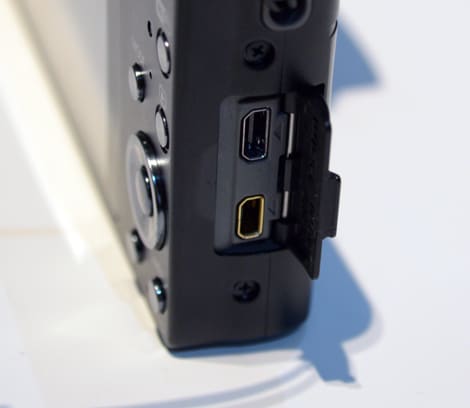
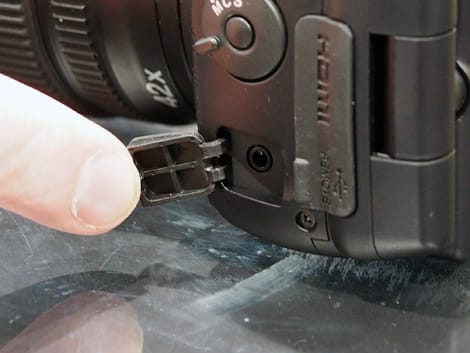
Battery
{{section_header}}{{section.name}}{{/section_header}}
The D7000 is juiced up by a single battery, the EN-EL15, which Nikon claims offers a battery life of 1050 shots, which is pretty good. If required, a vertical grip which can hold different types of batteries is available (the MB-D11).

Memory
{{section_header}}{{section.name}}{{/section_header}}
The D7000 is one of the first cameras we have seen that offers two SD card slots, both located on the right side of the camera body under a tightly fitting cover. These two cards can be used in a number of ways:
- Simultaneous. Identical images are written to both cards, providing a backup or second copy for quick distribution.
- Flowover. The camera writes to one card until it is full, then writes to the second. Cards can be hot-swapped, so you can remove one while still writing to the other.
- Different image types. The camera can also save different image types to each card, so it could write RAW images to one, and JPEGs to another.
This provides a good level of flexibility for the user, especially those who shoot both RAW and JPEG files and want to use both separately.
{{product.manufacturer_specs['FI Memory Photo']}}
Other Hardware
{{section_header}}{{section.name}}{{/section_header}}
GPS - The D7000 offers support for GPS tagging of images with an optional GPS receiver: the GP-1 GPS unit. This costs $265 and fits into the dedicated socket on the left side of the camera body.
Ease of Use
{{section_header}}{{section.name}}{{/section_header}}
Although it is a complex camera, the D7000 is laid out well, with the more commonly used controls in more convenient locations than others. The mode dial on the top left corner is well located for the left hand to reach to from the lens, while the movie record button and live mode switch falls right under the thumb on the back. Accessing the on-screen menu is more involved in requiring both hands, but given that this is a camera that requires to hands to shoot with, that's not a major inconvenience.
The menu itself is a standard Nikon arrangement, with tabs on the left side and the options within on the right. It does take some getting used to, but it is a decent arrangement that puts a lot of options within easy reach.
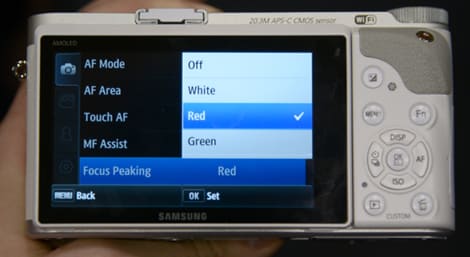

Size & Handling
{{section_header}}{{section.name}}{{/section_header}}
The D7000 is not a small camera, but it fits comfortably into the hand, with the grip on the right side providing plenty to hold onto, with a rubberized covering that makes sure that the grip is firm with slippery hands. This is important given the size and weight of the camera, and with most lenses (especially the larger ones) you are going to need two hands to hold and use the camera. The fingers fall naturally into place, with the index finger of the right hand falling onto the shutter button and the thumb falling onto the video shutter and live mode controls. The two control dials for shutter and aperture control are also located close by, so you can change either value without looking away from the viewfinder.
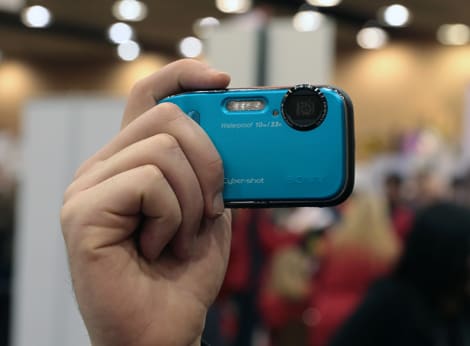
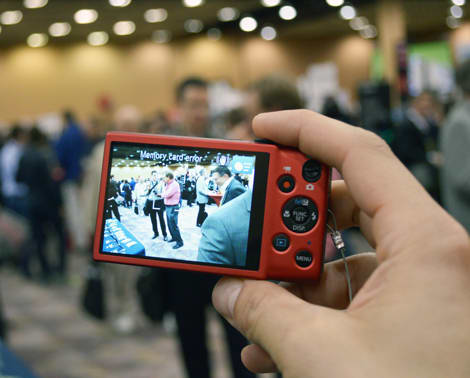
Auto Mode
{{section_header}}{{section.name}}{{/section_header}}
The D7000 offers a full auto mode at the Auto spot on the mode dial. In this mode, the camera makes all decisions except the image size, AF mode and white balance. There is also an Auto no flash mode, where the camera makes the decisions except that the flash is disabled. This is a nice touch: sometimes you can just set the camera to Auto and shoot away, but the camera often tries to use the flash when you might not be allowed. With this camera, you can just throw it into the Auto No Flash mode and shoot away without getting thrown out.
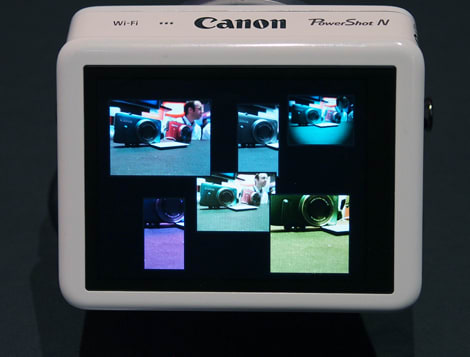
Movie Mode
{{section_header}}{{section.name}}{{/section_header}}
One of the main innovations here from the D5000 is the inclusion of support for shooting 1080p (1920 by 1080 pixel) video. However, there is still a limitation on the frame rate: the D7000 shoots a maximum frame rate of 24fps. That is fine for filmmakers, as film runs at 24fps. However, most HDTVs can display 60 frames per second of video at 1080p resolution, but this camera can't shoot at that speed, or even at the slower 30fps that all TVs support. Few digital cameras can, however, so the D7000 is not alone in this. It can shoot 720p/30fps video, though. All video clips are limited to 20 minutes to stop the sensor being damaged by heat.
Auto focus is also active while the camera is recording video, using the image sensor to detect contrast in images and refocus as required. We were not able to test this extensively, but it did seem to work as advertised while capturing video.
The camera has a built-in mono microphone, but this won't be much use, as it is too close to the camera for comfortable use. Fortunately, there is also a 3.5mm microphone input that allows a better stereo microphone to be used, and there are many of these available that clip onto the hot shoe.
The files that the D7000 captures are recorded as H.264 .MOV files, which are compatible with a wide range of video editing applications.
UPDATE: a previous version of this review incorrectly stated that the D7000 captured Motion JPEG files. We aplogize for this error.
Playback Mode
{{section_header}}{{section.name}}{{/section_header}}
Images can be displayed and sorted in a number of ways, including showing up to 72 thumbnails on screen at a time, zooming in up to 16x on an image, sorting images by date and shooting mode and many others. The camera can also create basic slideshows and show several levels of shooting information.
Custom Image Presets
{{section_header}}{{section.name}}{{/section_header}}
As well as the two auto modes and the standard PASM modes, the camera also offers a number of scene modes for automated shooting. There are 19 in total, which includes all of the basics (portrait, landscape, etc) and a few more unusual modes, such as Blossom and Autumn Colors.
There are also two custom mode spots on the mode dial called U1 and U2. These allow you to create, save and quickly switch to one of the custom modes, which could be very useful for shooting in situations that the scene mode can't deal with, or if you are looking for a particular look in an image.
Drive/Burst Mode
{{section_header}}{{section.name}}{{/section_header}}
Nikon claims that the D7000 can capture 6 frames a second for up to 100 frames at the highest resolution of the camera, and our brief tests with a pre-production model seemed to bear this out. The camera had no problem keeping up about 6 fps for several seconds, although this will be contingent on using a fast SD card.
Two levels of burst are available: one called CL which offers speeds up to 5 frames a second, and the CH mode described above which offers the full 6 fps speed.
Manual Controls
{{section_header}}{{section.name}}{{/section_header}}
Like all advanced DSLR cameras, the D7000 provides extensive manual controls for shooting, including an aperture priority mode, shutter priority and a full manual mode where the user sets the shutter and aperture directly. In this mode, the shutter speed is set by the front dial, and the aperture by the dial on the back. The front one can be reached by the index finger and the back by the thumb, so you can set the shutter speed and aperture without taking your eye away from the viewfinder.

Focus
{{section_header}}{{section.name}}{{/section_header}}
The auto focus of the D7000 is one of the areas where Nikon did a lot of upgrading, and it shows. The D7000 boasts an impressive 39 focus points spread across the frame, and nine of these in the center of the frame are cross type sensors, which work better in low light and with horizontal edges. These 39 focus points can be used in a number of ways, setting the camera to focus on one area, a group of points, or to try and get as many points as possible in focus at a time.
Several focus modes are also on offer, with options for continuous AF, single AF or manual focus. The continuous mode tries to keep the lens in focus whenever the shutter is half way down, while the single AF mode only focuses the camera once when the shutter is pressed down. In the manual mode, you focus the lens by rotating the focus ring, but the camera shows an enlargement of the center of the image which makes it easier to focus.
In live view mode, the camera uses the image sensor to focus in a mode referred to as AF-A (AF Auto). This mode also allows this camera to use face detection, a feature common to many point & shoot cameras, but rare on SLRs. If a face is detected, it can be used as the active area for both focus and exposure by the camera.
ISO
{{section_header}}{{section.name}}{{/section_header}}
The D7000 offers a wide ISO range, with numbered values from 100 up to 6400. Nikon also includes two higher and two lower settings called Hi-1 and Hi-2. For whatever reason, these don't have actual ISO numbers, but Nikon says they are equivalent to 6400 (Hi1) and 25600 (Hi2). All of these settings work at the maximum resolution of the camera: there are no reduced resolution options.
White Balance
{{section_header}}{{section.name}}{{/section_header}}
An extensive set of white balance controls are available, including 2 auto settings, 12 presets (including 7 types of fluorescent) and 5 preset manual memory spots. There is also an auto mode that uses the 2016 RGB sensors used for exposure, and a direct entry option where the user enters the kelvin value. That selection of presets and options should be enough for any use, especially with the option of 5 memory spots.
Exposure & Metering
{{section_header}}{{section.name}}{{/section_header}}
Nikon says that the D7000 uses an areay of 2016 RGB sensors near the viewfinder to judge exposure, which should make the evaluative mode more reliable. In addition, the camera offers center weighted and spot modes.
Shutter Speed
{{section_header}}{{section.name}}{{/section_header}}
The fastest shutter speed that this camera can manage is an impressive 1/8000 of a second. This can be stretched out to a longest timed speed of 30 seconds, although a bulb mode is also offered that holds the shutter open for as long as the shutter is pressed down.
Aperture
{{section_header}}{{section.name}}{{/section_header}}
The aperture of the camera depends on which lens is in use, but the D7000 will be sold with a 18-105mm zoom lens that offers a widest aperture of f/3.5 to f/5.6. The aperture is controlled using the rear dial in aperture priority and manual modes.
Image Stabilization
{{section_header}}{{section.name}}{{/section_header}}
Nikon uses an optical stabilization system where an element of the lens moves in response to camera shake, which requires that the lens be equipped with the motors to move the element around. If you use a lens that does not have these, the image stabilization will not work. Nikon distinguishes the ones that have this with the VR suffix, and it is included on the 18-105mm kit lens that the D7000 is sold with as a kit.
Picture Quality & Size Options
{{section_header}}{{section.name}}{{/section_header}}
The D7000 only offers 3 sizes to shoot at: L (4928 by 3264), M (3696 by 2448) and S (2464 by 1632). Three levels of JPEG compression are available, and the camera can also shoot RAW images, which contain the raw information from the image sensor for the maximum image quality. Both RAW and JPEG can also be saved at the same time, which is useful if you want the smaller size of JPEGs, but also want to go back and do more editing later, which is better done on the RAW image.
Picture Effects
{{section_header}}{{section.name}}{{/section_header}}
Like most Nikon SLRs, the D7000 offers 6 picture styles, which tweak the color and sharpness to achieve a specific look. The styles on offer are standard, neutral, vivid, monochrome, portrait and landscape. A custom mode allows the user to create their own by tweaking the settings for sharpness, brightness, saturation, hue, etc.
Other Controls
{{section_header}}{{section.name}}{{/section_header}}
Virtual Horizon Graphic Indicator - The D7000 also offers an electronic level, where the camera notifies you in live view mode if you are holding it level to the horizon. This is something of a theme for this year: we have seen the same feature offered on multiple cameras from multiple companies.
Conclusion
Canon D7. We will know more when we get the camera into our labs for a full review.
UPDATE: a previous version of this review had incorrect pricing. We have updated this and apologize for the error.
Sample Photos
{{section_header}}{{section.name}}{{/section_header}}
Specs
{{manufacturer_specs_table}}
Meet the tester
Richard Baguley is a veteran writer who has written about technology ranging from Alphabet to Zip file utilities. He has contributed to pretty much every major tech publication, including Amiga Format Magazine, PC World, Wired, CNET, Toms Guide, Forbes, and many others. He lives in the Boston metro area with his wife, dog, and an indeterminate number of cats.
Checking our work.
Our team is here to help you buy the best stuff and love what you own. Our writers, editors, and experts obsess over the products we cover to make sure you're confident and satisfied. Have a different opinion about something we recommend? Email us and we'll compare notes.
Shoot us an email